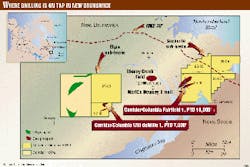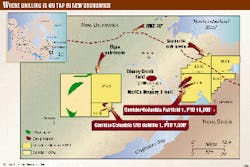Canada's Maritime Provinces are experiencing a new exploration round as start-up approaches for the gas pipeline from fields near Sable Island in the Atlantic.
Paleozoic basins in Quebec (Gaspe), Nova Scotia, New Brunswick, and Newfoundland are under scrutiny. The areas being studied include Prince Edward Island, Anticosti Island, and the Gulf of St. Lawrence.
The total number of wells drilled so far is small, and exploration in most areas can still be considered as stratigraphic or reconnaissance in nature. Drilling is planned later this year in southeastern New Brunswick, where Corridor Resources Inc., Halifax, holds a total of more than 446,000 net acres in the Elgin and Sackville sub-basins.
Corridor, with more than 5 million acres overall, is one of several companies that holds acreage in this region. Its president, Norman W. Miller, discussed the various exploration plays in a wide ranging article in these pages last year (OGJ, Sept. 28, 1998, p. 107).
Targets in these basins are in Permian, Pennsylvanian, Mississippian, Devonian, Silurian, and Ordovician rocks.
Seismic, drilling planned
Work is starting under a joint venture agreement between Corridor and Columbia Natural Resources Inc., Charleston, W. Va.
Columbia paid Corridor $1 million (U.S.) for a 50% working interest in Corridor's licenses in the Sackville and Elgin sub-basins. The licenses cover a combined area of more than 312,000 acres.
The two companies are jointly acquiring 30 km of new seismic data in the Sackville area. They will drill one wildcat on each block this fall.
The Sackville basin prospect lies 15 km southeast of Stoney Creek field, discovered in 1909. A marginal field with 37? gravity crude, Stoney Creek also produced 28 bcf of gas over the years for customers in Moncton and Hillsborough, N.B.
East of this prospect lie many other exploration leads on Corridor-Columbia lands and near the Maritimes & Northeast gas pipeline, Corridor said.
Corridor has retained 100% working interest in licenses adjacent to the joint Corridor-Columbia licenses in the Elgin basin (see map).
Corridor said it plans to undertake further seismic work and shallow exploratory drilling on the 100% lands pending results on the adjoining joint venture lands.
As potential producers of natural gas in New Brunswick, Corridor and Columbia will have the right to deliver gas directly to customers in the province, where it is in their commercial interest to bypass the franchised distributor, Corridor noted.
Meanwhile, CNR in late August expanded its eastern Canada onshore holdings with purchase of working interests from MariCo Oil & Gas, Fredericton, N.B.
Columbia acquired from MariCo a 50% working interest in New Bruns- wick provincial licenses on 17 tracts totaling more than 1 million acres. The area lies along the MNE gas pipeline, which is to start up late this year (OGJ, Aug. 23, 1999, p. 34).
Columbia also purchased a 50% working interest in MariCo's Downey 1 discovery well south of Moncton and 40 miles of seismic data. Columbia said it anticipates completing the Downey well and drilling two delineation wells during 1999.
The Downey well flowed an estimated 2.5 MMcfd of gas from about 6,800 ft in 1998.
Columbia is one of the largest and most successful explorers in the Appalachian basin in the U.S. For instance, the company in June said it has established production from 25 wells where it is exploiting the Ordovician Trenton-Black River formation in western New York. The initial discovery came in 1997 in Steuben County (OGJ, Dec. 1, 1997, p. 106).
Since then, Columbia has drilled in Steuben, Yates, Schuyler, and Tompkins counties in the western Finger Lakes region, about 650 miles southwest of the budding play in New Brunswick. The New York well depths are generally 7,300-7,600 ft.
Other Maritimes plays
Corridor is involved in most of the active plays in the Maritime Provinces.
Its holdings include more than 2 million net acres on Anticosti Island, 1.4 million acres in the Gulf of St. Lawrence, 500,000 acres on the Gaspe Peninsula, 284,000 acres in the Magdalen Islands, Quebec, 154,000 acres on Prince Edward Island, and more than 600,000 acres off western Cape Breton, N.S.
The Cape Breton acreage is adjacent to a significant gas discovery held by BP-Amoco. That 1970s prospect, known as East Point, tested 5.5 MMcfd of gas from Upper Carboniferous sands at about 5,200 ft.
The modern round of drilling in the Maritimes so far has not resulted in sustained commercial production. Drilling has included: Anticosti Island, two wells in 1998 and three wells in 1999; Gaspe Peninsula one well this year; Magdalen Islands one well this year (to spud in early September 1999); and Prince Edward Island, one suspended potential gas well drilled in 1997.
Corridor and Foothills Minerals Inc., Tampa, Fla., are to drill the Magdalen Islands prospect to 8,000 ft to evaluate the gas potential of Permian sands that flank the Cap-au-Meules salt dome.
Corridor also plans to drill the giant "Old Harry" structure on the northern margin of the Magdalen basin during summer-fall 2000. In 1,500 ft of water in the central Gulf of St. Lawrence, it is one of Canada's largest undrilled structures.
Corridor completed a modern, 800 km seismic survey over the structure last year and plans to announce partners for the project as soon as it receives the requisite government approvals.
A depth of 4,000-6,000 ft will be needed to evaluate the prospect. Old Harry is on trend with porous and permeable, oil stained Westphalian B sands found to be water bearing in the Texaco Brion Island 1 well in 1970.
Corridor also holds about 15,000 acres over the Parke prospect, a potential underground gas storage site 110 miles northeast of Quebec City. It hopes to develop Parke, which has three wells, into a working storage facility within 2 years.
Parke, just south of Riviere-du-Loup, Que., is near a proposed lateral from Fredericton to near Quebec City that would connect the MNE pipeline with the TransCanada PipeLines system. The lateral would lie in New Brunswick and Quebec, roughly parallel the northern U.S. border around Maine, and run down the south bank of the St. Lawrence River.
Corridor, founded in 1995, is named for the route of the nearly completed gas pipeline that will mainly serve the Sable Island gas project.



